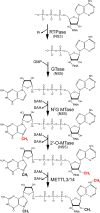Causes and Consequences of Flavivirus RNA Methylation
- PMID: 29259584
- PMCID: PMC5723295
- DOI: 10.3389/fmicb.2017.02374
Causes and Consequences of Flavivirus RNA Methylation
Abstract
Mosquito-borne flaviviruses are important human pathogens that represent global threats to human health. The genomes of these positive-strand RNA viruses have been shown to be substrates of both viral and cellular methyltransferases. N7-methylation of the 5' cap structure is essential for infection whereas 2'-O-methylation of the penultimate nucleotide is required for evasion of host innate immunity. N6-methylation of internal adenosine nucleotides has also been shown to impact flavivirus infection. Here, I summarize recent progress made in understanding roles for methylation in the flavivirus life-cycle and discuss relevant emerging hypotheses.
Keywords: Zika virus; dengue virus; flavivirus; hepatitis C virus; methylation.
Figures

References
-
- Abbas Y. M., Laudenbach B. T., Martínez-Montero S., Cencic R., Habjan M., Pichlmair A., et al. (2017). Structure of human IFIT1 with capped RNA reveals adaptable mRNA binding and mechanisms for sensing N1 and N2 ribose 2′-O methylations. Proc. Natl. Acad. Sci. U.S.A. 114 E2106–E2115. 10.1073/pnas.1612444114 - DOI - PMC - PubMed
Publication types
LinkOut - more resources
Full Text Sources
Other Literature Sources
Miscellaneous

